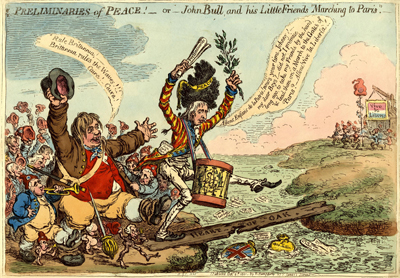Preliminaries of Peace. . .
Preliminaries of Peace. . . was published less than a week after an initial agreement with France was signed by the Secretary of State for Foreign Affairs, Robert Jenkinson, Lord Hawkesbury. That preliminary agreement led ultimately to the Treaty of Amiens which put a temporary end to the war with France, but, from Gillray's point of view, presented too many potential and real pitfalls.

© Trustees of the British Museum
At the center of the print Gillray shows Hawkesbury literally beating the drum for peace as suggested by his hat (labeled Peace) and the olive branch in his hand. The paper in his pocket, "Instructions from Park Place," (Pitt's residence) and the image of stork and anchor on the side of the drum (derived from the Pitt family crest) both reflect a common belief at the time that Hawkesbury was acting at the instigation of the former Prime Minister, William Pitt.
Hawkesbury is followed by the representative Briton, John Bull, and a cadre of prominent Whigs, including Lord Moira, George Walpole, Richard Brinsley Sheridan, Francis Burdett, and Charles James Fox on one side, the Duke of Norfolk and Tierney on the other wide, and Michaelangelo Taylor, Earl Derby, and John Nicolls in front. The Whigs with their revolutionary bonnets rouges had always taken a pro-French position, even after the execution of the French King, and had consistently argued for peace with France. But now, tired of the war and the taxes required to support it, the typical Englishman, represented by Bull, was beginning to find those arguments much more appealing. But as Gillray suggests, John fails to notice in his celebration of peace that his dropped sword is poised to to be used against him.
But this is only the beginning of the threats to England. As Hawkesbury steps out over a rotted "heart of oak" plank (representing a depleted or disarmed navy?), it is clear that Hawkesbury is taking all the risks. There is no one on the French side meeting him half way. Indeed, there are numerous signs of English positions and advantages that will be thrown away as part of this one-sided agreement, including the "Restoration of French Monarchy," (no longer insisted upon), and "Malta," "West India Islands," "Cape of Good Hope," "Map of Egypt," (British occupations to be given up as part of the treaty). Adding insult to injury there are also the "List of Soldiers & Sailors Killed" in battles with the French and £400 Million spent on the war effort. Even the speeches of Hawkesbury and John Bull are becoming half French.
Allons, Enfans de la Patrie! - now's your time Johnny! - my dear Boys! - did not I promise long ago, to take my Friends by the hand, & lead them on to March to the Gates of Paris? - Allons! vive la Liberta!!
This "march" is doubly ironic. In an early speech when the war with France was thought to be soon over, Hawkesbury is said to have spoken approvingly of a British "March to Paris." But that, of course, was to be a victory march; this one is anything but. And In labeling the plank over which Hawkesbury crosses, "Heart of Oak" Gillray clearly means to set up an ironic contrast between this ignominious march and the official march of the Royal Navy.
Come cheer up, my lads! 'tis to glory we steer,
To add something more to this wonderful year;
To honour we call you, not press you like slaves,
For who are so free as the sons of the waves?
Heart of oak are our ships, heart of oak are our men;
We always are ready, steady, boys, steady!
We'll fight and we'll conquer again and again.
Sources and Reading
- Commentary from the British Museum on Preliminaries of Peace. . ..
- Draper Hill, Mr. Gillray The Caricaturist, 1965, pp. 104-5 pl. 91.
- "Robert Jenkinson, 2nd Earl of Liverpool," Wikipedia
- "Treaty of Amiens," Wikipedia
- "Heart of Oak," Wikipedia
- Thomas Wright and R.H. Evans, Historical and Descriptive Account of the Caricatures of James Gillray #261 .
- Thomas Wright and Joseph Grego, The Works of James Gillray, the Caricaturist; With the History of His Life and Times, pp. 277-278.
Comments & Corrections
NOTE: Comments and/or corrections are always appreciated. To make that easier, I have included a form below that you can use. I promise never to share any of the info provided without your express permission.